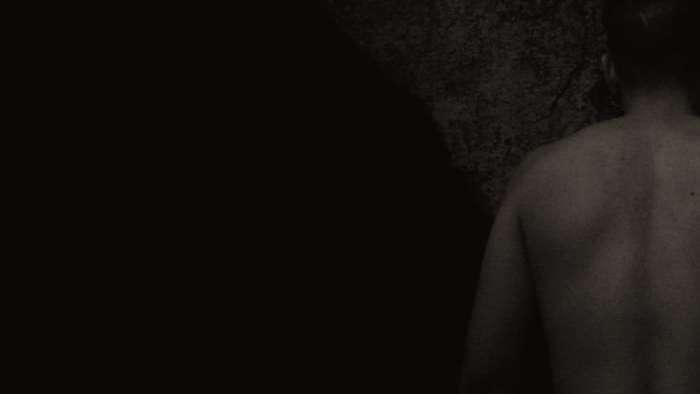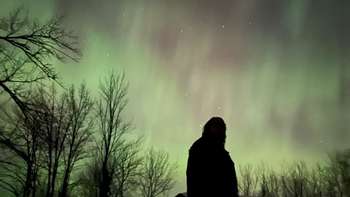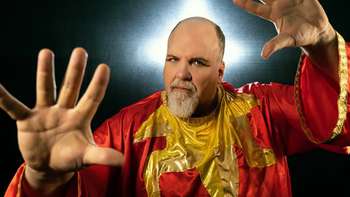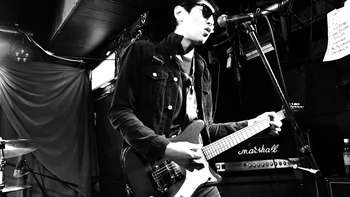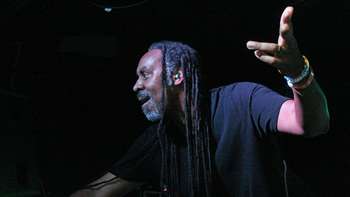Today, I'll be sharing with you all a musician of many talents and a great propensity for being prolific. It all started a couple of years ago when I discovered Fawn Limbs and subsequently, the myriad of bands that are, somehow, oddly linked to the project. Eeli Helin is that bridge. For some of you that name may ring a bell, depending on what band you know him from, there's a fair few in which he's been part of and in which he currently manifests in. For the sake of order and sense, the discussion has been arranged in a chronologic manner. To keep in tone with our guest today, I'll be taking an approach closer to brevity, more than anything else.
Things more or less began during the early-to-mid part of 2016, in regards to Eeli Helin's musical trajectory beginning, so to speak, with a pretty raw sound which exhibited quite some potential.
Scene Point Blank: Was [Caji] the beginning of your musical journey? How did Caji come to be? What part were you of Caji and how deep did your musical self, run in this project? It sounds pretty raw, but overall, there’s some potential there. What happened?
Eeli Helin: Me and one of the other people involved were initially in Creinium first, but then realized we have a lot in common in terms of musical interests, and that Creinium didn’t really suit those ambitions. So, we set out to write together, and the tech-death angle came naturally. Later on, we developed our output further away from that particular style and began working on something else that is yet to see the light of day. All in all, Caji was my first own band, where I handled vocals, guitars, artwork, all that jazz that I continue to do today. The musical essence of that project is far from what I’d do today, but it felt natural back then. The songs we put out are indeed raw, but that’s also what we aimed for back then, granted that the juvenile vision in them is blatant as well.
Scene Point Blank: Creinium is a project that's pretty neat, at least as I perceive it, showcasing a melodically inclined death metal kind of deal which makes use of electronic as well as atmospheric/symphonic sensibilities. While the idea sounds good on paper, it isn't executed exactly with all the flash and fire you'd probably expect, with songs falling a little short in terms of composition and structure. It also seems that 2016 marks something of a break.
So, what’s the deal with Creinium? How deep did your influence on the output run through Hallucinosis andrespectivelyhow did you end up in Creinium?
Eeli Helin: I joined the band soon after I graduated in 2014 and it felt like the first “real” band I was a part of (but which wasn’t mine, per se). I wanted to do something musically, and found myself doing vocals for them. Musically it wasn’t really my forte, but I enjoyed writing lyrics and doing vocals just for the sake of them. We first did a re-hash EP soon after I joined and worked on a full-length for a long while. The remnants of their earlier vocalist lingered on for a long time and it was more or less a struggle for me to realize my own potential in that band. The eventual downfall of the project came after me and this friend of mine -- I mentioned earlier -- quit due to personal issues with some of the other members, causing a butterfly effect where, soon enough, only one member remained in the band. I reckon he tried to keep it going with new guys and whatnot, but also saw him selling all of his gear away a few years later. So that’s that, I guess. It’s a part of my musical history yes, but other than that I’ll keep my name and that band out of the same sentence for a reason.
Scene Point Blank: Mireplaner takes the shape of a winding post-metal mammoth taking cues from sludge and progressive, leaning on the more atmospheric side of metal, where it explores textures, moods, and ambiances much more than structures, phrases, and that kind of deal. The sound employed by the band can be equally dense and chaotic, as well as sparse and eerie, channeling something dark, unsettling, and weirdly twisted. It's definitely something to dig into over the course of their debut EP Diapiric, and the first full-length, A Mountain of Saola Hooves.
In kind of the same breath as above: what were the circumstances around which Mireplaner came to be and what’s the message/intention behind its output? Is it just a matter of doing something for the sake of the craft or is it something more along the lines of catharsis so to say?
Eeli Helin: I’ve always loved post-metal and all of its various subgenres and what not. I mentioned earlier how Caji was my first own band. Mireplaner was my first fully own band in terms of compositions, meaning that I wrote everything 100%. The idea of doing a two-track EP first was obvious, after I found the other members, who came on board: one was an old friend from school, the other I found from an online forum. The intention of that band was to conjoin post-metal and sludge with hardcore and ambient, a concoction that on paper seems ridiculous, but in reality, is exactly what it is. My intention with Mireplaner, alongside all of my bands, is to convey all sorts of atmospheres and emotions in varying manners to achieve a personal catharsis that can potentially be served for others as well. I never do anything for the sake of it, I don’t sketch a “plan” for each project. It all comes naturally.
Scene Point Blank: Is there any particular concept behind Diapiric and A Mountain of Saola Hooves? It seems like a very (oddly) specific decision to pick a geologic event and then one of the largest land mammals as the “mascot” for the imagery of a record.
Eeli Helin: There’s no particular concept behind either, just the creation of a unique sonic landscape. The artworks, on the other hand, mirror the titles and loosely the lyrical content: Diapiric being about natural formations, a geological intrusion, where mobile and deformable material is forced into brittle overlying rocks, sort of conveying the band’s first steps, and A Mountain of Saola Hooves centering around extinction. We chose to include a saola on the cover, the once-largest land mammal hunted to extinction, as a direct dystopian nod to the clusterfuck this world is currently.
Scene Point Blank: Care to expand a little on the origins of Mireplaner?
Eeli Helin: As said above, I formed Mireplaner, and handled all writing, vocals, guitars, ambients, and whatnot. The cover paintings were done by Jeanne Strieder of Coma Cluster Void fame. I speak in past tense, since at the moment I’m not sure if and when another release is down the road, mainly due to our shifting interests as people and musicians.
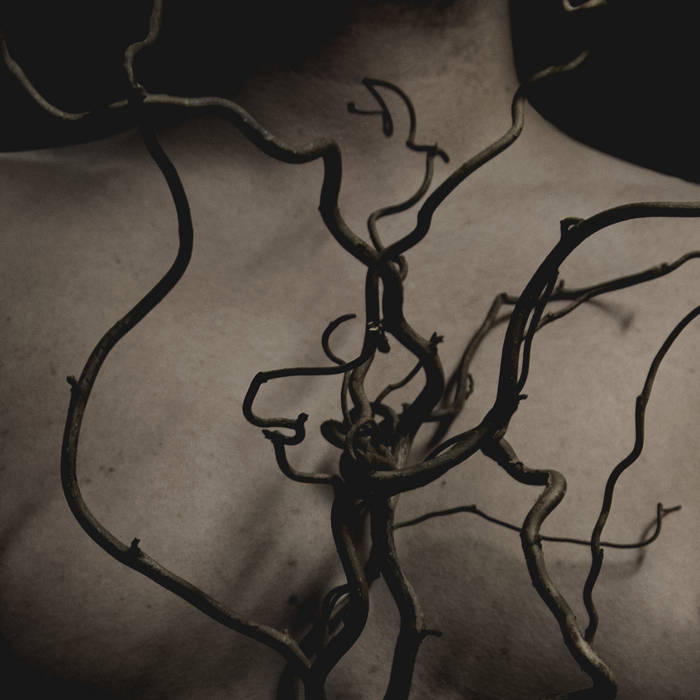
Scene Point Blank: I remember seeing somewhere that Eeli Helin met Lee Fisher during some Coma Cluster Void sessions, or something akin to that. Which turned out to be a starting point and that was a part of how Fawn Limbs came to be. So, since we're here with the man himself, we're going to find out what went down.
Fawn Limbs, the experimental mathgrind phenomenon, or rather, geometric noise/mathematical chaos phenomenon -- what's the story here?
Eeli Helin: I was friends with Jeanne from Coma Cluster Void on Facebook and at a point they posted about wanting to start another band. I commented that I could do vocals, but was shut off by them saying it’d be an instrumental project. Lo and behold, they contacted me a few days later asking if I’d be interested after all and I was. Lee, who played drums in the project, soon became a close friend of mine and we started to envision Fawn Limbs after maybe a year of doing Infinite Nomad. Infinite Nomad was supposed to be a laid back, fun thing, but alas, things didn't really take any concrete form. I appreciate all the musicians involved a shit ton, but the outcome of the project wasn’t doing it for me, even if it’d be a working formula with others. Speaking about this also makes me start to see a pattern in my behavior, [Laughs nervously].
Scene Point Blank: Towing Heads, Languor, and Thrum are very raw, visceral, and chaotic. It holds a lot of the grindcore ethos, albeit with your (as a band) particular voice. The sound of the tunes is also very abrasive and well, brute. Is this all part of an aesthetic, or was the end result shaped to work around a lack of resources needed to shape a certain vision? Do elaborate on the concepts and ideas that are explored here, both musically and lyrically as well.
Eeli Helin: When we started Fawn Limbs, we were gravitating towards a more grindcore-oriented sound, which resulted in the two first EPs being very raw and filthy, tonally. Thrum was a conceptual experiment into the realm of noise and free-jazz that bore interesting fruit, and we began shaping our aural edge better with that EP, I think. None of anything with Fawn Limbs has ever happened due to lack of resources, we’ve always done exactly what we want to do. For these releases, I handled vocals, guitars, bass, artworks, and primary writing/composing, and with this band I started to realize that I’m starting to unveil my innermost musical tendencies. Even if only scratching the surface and being able to work on that with such an amazing human being as Lee, Fawn Limbs felt special right out the gate. Musically we went for an amalgamation of grindcore, mathcore, and noise, always striving to view these genre tags through our own lenses, not fitting to any pre-existing molds. Lyrically the songs on the first two EPs are maybe the most mundane in terms of concepts, revolving around the themes of oppression and suppression. Thrum was of course a dig into a noir western story, which is an ongoing concept still to this day and a separate entity from the rest.
Scene Point Blank: Harm Remissions sounds noticeably better and further emphasizes a more metallic/hardcore component over the chaos and atmosphere seen behind Towing Heads, Languor, and Thrum. It’s also apparent that the songs are basically entirely in grind territory -- judging by their length and delivery (not that the previous ones weren’t mostly there too). What do you attribute this shift to?
Eeli Helin: On Harm Remissions we hit the balance between what you’d call grindcore and mathcore, intertwining the two genres to create a third entity, and I honestly think we achieved that. The production was a step up for sure, albeit super unpolished still. There really wasn’t a shift musically as such, as it’s all due to natural progression. I wanted to write more multifaceted and disjointed songs altogether, and the end result is what I feel is the culmination of that mindset, at least for that time. The concept, aesthetically and lyrically was also more focused, mainly on the subjects of self-harm, survival, the mentioned oppression, governmental decline, mental decline, you get the gist.
